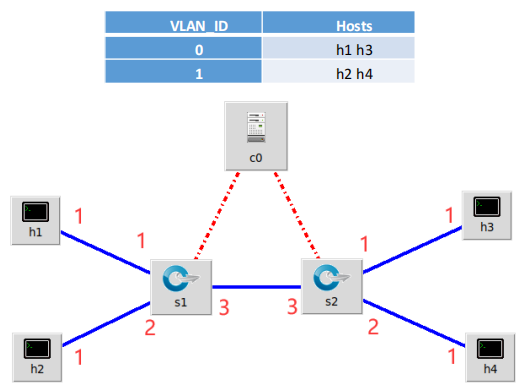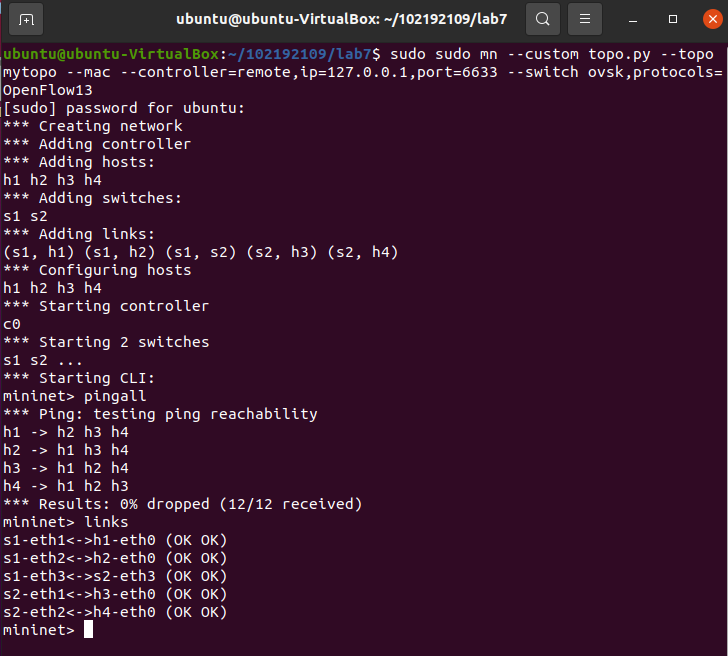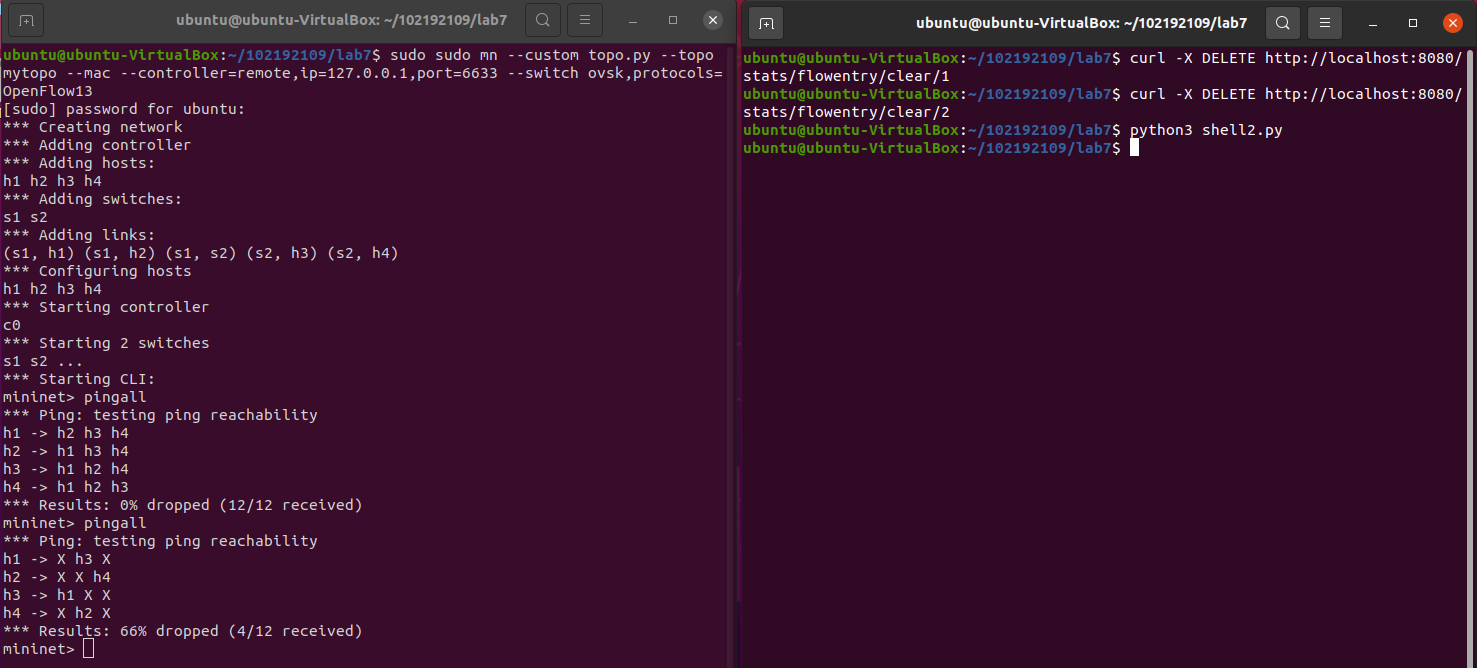实验7:基于REST API的SDN北向应用实践
实验目的
- 能够编写程序调用OpenDaylight REST API实现特定网络功能;
- 能够编写程序调用Ryu REST API实现特定网络功能。
实验环境 - 下载虚拟机软件Oracle VisualBox或VMware;
- 在虚拟机中安装Ubuntu 20.04 Desktop amd64,并完整安装Mininet、
OpenDaylight(Carbon或Berrylium版本)、Postman和Ryu;
基本要求 - OpenDaylight
(1) 利用Mininet平台搭建下图所示网络拓扑,并连接OpenDaylight;

(2) 编写Python程序,调用OpenDaylight的北向接口下发指令删除s1上的流表数据。
#!/usr/bin/python
import requests
from requests.auth import HTTPBasicAuth
def http_delete(url):
url= url
headers = {'Content-Type':'application/json'}
resp = requests.delete(url,headers=headers,auth=HTTPBasicAuth('admin', 'admin'))
return resp
if __name__ == "__main__":
url='http://127.0.0.1:8181/restconf/config/opendaylight-inventory:nodes/node/openflow:1/'
resp = http_delete(url)
print (resp.content)
运行结果如下
(3) 编写Python程序,调用OpenDaylight的北向接口下发硬超时流表,实现拓扑内主机h1和h3网络中断20s。
#!/usr/bin/python
import requests
from requests.auth import HTTPBasicAuth
def http_put(url,jstr):
url= url
headers = {'Content-Type':'application/json'}
resp = requests.put(url,jstr,headers=headers,auth=HTTPBasicAuth('admin', 'admin'))
return resp
if __name__ == "__main__":
url='http://127.0.0.1:8181/restconf/config/opendaylight-inventory:nodes/node/openflow:1/flow-node-inventory:table/0/flow/1'
with open('103.json') as f:
jstr = f.read()
resp = http_put(url,jstr)
print (resp.content)
103.json文件:
{
"flow": [
{
"id": "1",
"match": {
"in-port": "1",
"ethernet-match": {
"ethernet-type": {
"type": "0x0800"
}
},
"ipv4-destination": "10.0.0.3/32"
},
"instructions": {
"instruction": [
{
"order": "0",
"apply-actions": {
"action": [
{
"order": "0",
"drop-action": {}
}
]
}
}
]
},
"flow-name": "flow1",
"priority": "65535",
"hard-timeout": "20",
"cookie": "2",
"table_id": "0"
}
]
}
运行结果:

(4) 编写Python程序,调用OpenDaylight的北向接口获取s1上活动的流表数。
#!/usr/bin/python
import requests
from requests.auth import HTTPBasicAuth
if __name__ == "__main__":
url = 'http://127.0.0.1:8181/restconf/operational/opendaylight-inventory:nodes/node/openflow:1/flow-node-inventory:table/0/opendaylight-flow-table-statistics:flow-table-statistics'
headers = {'Content-Type': 'application/json'}
res = requests.get(url,headers=headers, auth=HTTPBasicAuth('admin', 'admin'))
print (res.content)
运行结果:

- Ryu
(1) 编写Python程序,调用Ryu的北向接口,实现上述OpenDaylight实验拓扑上相同的硬超时流表下发。
python程序
#!/usr/bin/python
import requests
from requests.auth import HTTPBasicAuth
def http_post(url,jstr):
url= url
headers = {'Content-Type':'application/json'}
resp = requests.post(url,jstr,headers=headers)
return resp
if __name__ == "__main__":
url='http://127.0.0.1:8080/stats/flowentry/add'
with open('201.json') as f:
jstr = f.read()
resp = http_post(url,jstr)
print (resp.content)
201.json
{
"dpid": 1,
"cookie": 1,
"cookie_mask": 1,
"table_id": 0,
"hard_timeout": 20,
"priority": 65535,
"flags": 1,
"match":{
"in_port":1
},
"actions":[
{
"type":"OUTPUT",
"port": 2
}
]
}
运行结果:

(2) 利用Mininet平台搭建下图所示网络拓扑,要求支持OpenFlow 1.3协议,主机名、交换机名以及端口对应正确。拓扑
生成后需连接Ryu,且Ryu应能够提供REST API服务。

命令运行
sudo sudo mn --custom topo.py --topo mytopo --mac --controller=remote,ip=127.0.0.1,port=6633 --switch ovsk,protocols=OpenFlow13
topo.py文件代码
#!/usr/bin/env python
from mininet.topo import Topo
class MyTopo(Topo):
def __init__(self):
# initilaize topology
Topo.__init__(self)
self.addSwitch("s1")
self.addSwitch("s2")
self.addHost("h1")
self.addHost("h2")
self.addHost("h3")
self.addHost("h4")
self.addLink("s1", "h1")
self.addLink("s1", "h2")
self.addLink("s2", "h3")
self.addLink("s2", "h4")
self.addLink("s1", "s2")
topos = {'mytopo': (lambda: MyTopo())}

(3) 整理一个Shell脚本,参考Ryu REST API的文档,利用curl命令,实现和实验2相同的VLAN。
curl命令
curl -X DELETE http://localhost:8080/stats/flowentry/clear/1
curl -X DELETE http://localhost:8080/stats/flowentry/clear/2
shell.sh脚本
# 将主机1,2发送来的数据包打上vlan标记
curl -X POST -d '{
"dpid": 1,
"priority": 1,
"match":{
"in_port": 1
},
"actions":[
{
"type": "PUSH_VLAN",
"ethertype": 33024
},
{
"type": "SET_FIELD",
"field": "vlan_vid",
"value": 4096
},
{
"type": "OUTPUT",
"port": 3
}
]
}' http://localhost:8080/stats/flowentry/add
curl -X POST -d '{
"dpid": 1,
"priority": 1,
"match":{
"in_port": 2
},
"actions":[
{
"type": "PUSH_VLAN",
"ethertype": 33024
},
{
"type": "SET_FIELD",
"field": "vlan_vid",
"value": 4097
},
{
"type": "OUTPUT",
"port": 3
}
]
}' http://localhost:8080/stats/flowentry/add
# 将主机3,4发送来的数据包取出vlan标记
curl -X POST -d '{
"dpid": 1,
"priority": 1,
"match":{
"vlan_vid": 0
},
"actions":[
{
"type": "POP_VLAN",
"ethertype": 33024
},
{
"type": "OUTPUT",
"port": 1
}
]
}' http://localhost:8080/stats/flowentry/add
curl -X POST -d '{
"dpid": 1,
"priority": 1,
"match":{
"vlan_vid": 1
},
"actions":[
{
"type": "POP_VLAN",
"ethertype": 33024
},
{
"type": "OUTPUT",
"port": 2
}
]
}' http://localhost:8080/stats/flowentry/add
# 将主机3,4发送来的数据包打上vlan标记
curl -X POST -d '{
"dpid": 2,
"priority": 1,
"match":{
"in_port": 1
},
"actions":[
{
"type": "PUSH_VLAN",
"ethertype": 33024
},
{
"type": "SET_FIELD",
"field": "vlan_vid",
"value": 4096
},
{
"type": "OUTPUT",
"port": 3
}
]
}' http://localhost:8080/stats/flowentry/add
curl -X POST -d '{
"dpid": 2,
"priority": 1,
"match":{
"in_port": 2
},
"actions":[
{
"type": "PUSH_VLAN",
"ethertype": 33024
},
{
"type": "SET_FIELD",
"field": "vlan_vid",
"value": 4097
},
{
"type": "OUTPUT",
"port": 3
}
]
}' http://localhost:8080/stats/flowentry/add
curl -X POST -d '{
"dpid": 2,
"priority": 1,
"match":{
"vlan_vid": 0
},
"actions":[
{
"type": "POP_VLAN",
"ethertype": 33024
},
{
"type": "OUTPUT",
"port": 1
}
]
}' http://localhost:8080/stats/flowentry/add
curl -X POST -d '{
"dpid": 2,
"priority": 1,
"match":{
"vlan_vid": 1
},
"actions":[
{
"type": "POP_VLAN",
"ethertype": 33024
},
{
"type": "OUTPUT",
"port": 2
}
]
}' http://localhost:8080/stats/flowentry/add
运行结果

进阶要求
编程实现基本要求第2部分Ryu(3)中的VLAN划分。
创建shell2.py文件,代码内容如下
import json
import requests
if __name__ == "__main__":
url = 'http://127.0.0.1:8080/stats/flowentry/add'
headers = {'Content-Type': 'application/json'}
flow1 = {
"dpid": 1,
"priority": 1,
"match":{
"in_port": 1
},
"actions":[
{
"type": "PUSH_VLAN", # Push a new VLAN tag if a input frame is non-VLAN-tagged
"ethertype": 33024 # Ethertype 0x8100(=33024): IEEE 802.1Q VLAN-tagged frame
},
{
"type": "SET_FIELD",
"field": "vlan_vid", # Set VLAN ID
"value": 4096 # Describe sum of vlan_id(e.g. 6) | OFPVID_PRESENT(0x1000=4096)
},
{
"type": "OUTPUT",
"port": 3
}
]
}
flow2 = {
"dpid": 1,
"priority": 1,
"match":{
"in_port": 2
},
"actions":[
{
"type": "PUSH_VLAN", # Push a new VLAN tag if a input frame is non-VLAN-tagged
"ethertype": 33024 # Ethertype 0x8100(=33024): IEEE 802.1Q VLAN-tagged frame
},
{
"type": "SET_FIELD",
"field": "vlan_vid", # Set VLAN ID
"value": 4097 # Describe sum of vlan_id(e.g. 6) | OFPVID_PRESENT(0x1000=4096)
},
{
"type": "OUTPUT",
"port": 3
}
]
}
flow3 = {
"dpid": 1,
"priority": 1,
"match":{
"vlan_vid": 0
},
"actions":[
{
"type": "POP_VLAN", # Push a new VLAN tag if a input frame is non-VLAN-tagged
"ethertype": 33024 # Ethertype 0x8100(=33024): IEEE 802.1Q VLAN-tagged frame
},
{
"type": "OUTPUT",
"port": 1
}
]
}
flow4 = {
"dpid": 1,
"priority": 1,
"match": {
"vlan_vid": 1
},
"actions": [
{
"type": "POP_VLAN", # Push a new VLAN tag if a input frame is non-VLAN-tagged
"ethertype": 33024 # Ethertype 0x8100(=33024): IEEE 802.1Q VLAN-tagged frame
},
{
"type": "OUTPUT",
"port": 2
}
]
}
flow5 = {
"dpid": 2,
"priority": 1,
"match": {
"in_port": 1
},
"actions": [
{
"type": "PUSH_VLAN", # Push a new VLAN tag if a input frame is non-VLAN-tagged
"ethertype": 33024 # Ethertype 0x8100(=33024): IEEE 802.1Q VLAN-tagged frame
},
{
"type": "SET_FIELD",
"field": "vlan_vid", # Set VLAN ID
"value": 4096 # Describe sum of vlan_id(e.g. 6) | OFPVID_PRESENT(0x1000=4096)
},
{
"type": "OUTPUT",
"port": 3
}
]
}
flow6 = {
"dpid": 2,
"priority": 1,
"match": {
"in_port": 2
},
"actions": [
{
"type": "PUSH_VLAN", # Push a new VLAN tag if a input frame is non-VLAN-tagged
"ethertype": 33024 # Ethertype 0x8100(=33024): IEEE 802.1Q VLAN-tagged frame
},
{
"type": "SET_FIELD",
"field": "vlan_vid", # Set VLAN ID
"value": 4097 # Describe sum of vlan_id(e.g. 6) | OFPVID_PRESENT(0x1000=4096)
},
{
"type": "OUTPUT",
"port": 3
}
]
}
flow7 = {
"dpid": 2,
"priority": 1,
"match": {
"vlan_vid": 0
},
"actions": [
{
"type": "POP_VLAN", # Push a new VLAN tag if a input frame is non-VLAN-tagged
"ethertype": 33024 # Ethertype 0x8100(=33024): IEEE 802.1Q VLAN-tagged frame
},
{
"type": "OUTPUT",
"port": 1
}
]
}
flow8 = {
"dpid": 2,
"priority": 1,
"match": {
"vlan_vid": 0
},
"actions": [
{
"type": "POP_VLAN", # Push a new VLAN tag if a input frame is non-VLAN-tagged
"ethertype": 33024 # Ethertype 0x8100(=33024): IEEE 802.1Q VLAN-tagged frame
},
{
"type": "OUTPUT",
"port": 1
}
]
}
res1 = requests.post(url, json.dumps(flow1), headers=headers)
res2 = requests.post(url, json.dumps(flow2), headers=headers)
res3 = requests.post(url, json.dumps(flow3), headers=headers)
res4 = requests.post(url, json.dumps(flow4), headers=headers)
res5 = requests.post(url, json.dumps(flow5), headers=headers)
res6 = requests.post(url, json.dumps(flow6), headers=headers)
res7 = requests.post(url, json.dumps(flow7), headers=headers)
res8 = requests.post(url, json.dumps(flow8), headers=headers)
运行结果:

个人总结
本次实验难度:我的评价是有点难。因为本次实验涉及修改各种源码,这就需要理解各种源码的内容。
实验中遇到的问题:
1、ryu实验中创建的拓扑无法连接上控制器
解决方法:使用命令ryu-manager ryu.app.simple_switch_13 ryu.app.ofctl_rest打开Ryu控制器
2、运行curl命令时提示安装
解决方法:按照提示安装
3、vlan划分没反应
解决方法:进行vlan划分前要删除流表
实验心得:本次实验确实有点难,但是经过本次实验之后我能够编写程序调用OpenDaylight REST API实现特定网络功能;以及能够编写程序调用Ryu REST API实现特定网络功能。本次实验的收获还是蛮大的,让我对源码的理解也更加深入。



【推荐】编程新体验,更懂你的AI,立即体验豆包MarsCode编程助手
【推荐】凌霞软件回馈社区,博客园 & 1Panel & Halo 联合会员上线
【推荐】抖音旗下AI助手豆包,你的智能百科全书,全免费不限次数
【推荐】轻量又高性能的 SSH 工具 IShell:AI 加持,快人一步
· 聊一聊 操作系统蓝屏 c0000102 的故障分析
· SQL Server 内存占用高分析
· .NET Core GC计划阶段(plan_phase)底层原理浅谈
· .NET开发智能桌面机器人:用.NET IoT库编写驱动控制两个屏幕
· 用纯.NET开发并制作一个智能桌面机器人:从.NET IoT入门开始
· 我干了两个月的大项目,开源了!
· 推荐一款非常好用的在线 SSH 管理工具
· 聊一聊 操作系统蓝屏 c0000102 的故障分析
· 千万级的大表,如何做性能调优?
· .NET周刊【1月第1期 2025-01-05】